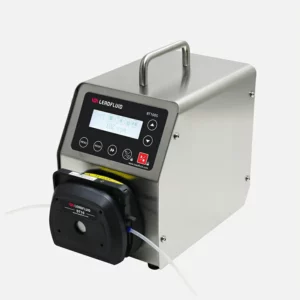A peristaltic pump, also known as a hose pump or tube pump, operates based on a unique mechanism known as peristalsis.
Here’s a more detailed explanation of how a peristaltic pump works:
A peristaltic pump, also known as a hose pump or tube pump, operates using a mechanism called peristalsis. Here’s how it works:
- Pump Head Structure: The pump head consists of a rotor and a flexible tube or hose. The tube is positioned within the pump head and is typically made of materials such as silicone, rubber, or thermoplastics. The rotor has several lobes or rollers that rotate against the tube.
- Peristaltic Action: As the rotor rotates, the lobes or rollers squeeze the tube against the pump housing in a rolling or squeezing motion. This action creates a series of occlusions or compressions along the length of the tube. The portion of the tube under compression closes, while the adjacent section opens up, creating a pumping effect.
- Fluid Flow: When a section of the tube is compressed, it pushes the fluid within that section forward. As the rotor continues to rotate, the compressed section moves along the tube, propelling the fluid in a positive displacement manner. This process is repeated as each lobe or roller passes the tube, creating a continuous flow of fluid.
- Reversibility: Peristaltic pumps can operate in both directions, allowing for bidirectional fluid flow. By reversing the rotation of the rotor, the pump can change the direction of the flow. This feature is useful in applications that require fluid recirculation or reversible pumping.
- Flow Rate Control: The speed of the rotor determines the flow rate of the pump. Increasing the rotational speed leads to more frequent compressions and a higher flow rate, while decreasing the speed reduces the flow rate. Variable speed peristaltic pumps allow for precise control over the flow rate by adjusting the rotor speed.
- Tube Replacement and Maintenance: One of the advantages of peristaltic pumps is that the fluid only comes into contact with the tube, making it easy to replace and clean. If the tube wears out or needs to be changed for a different fluid, it can be easily replaced without the need to dismantle the entire pump. This feature simplifies maintenance and minimizes downtime.
several advantages
Peristaltic pumps offer several advantages, including gentle pumping action, the ability to handle abrasive or viscous fluids, self-priming capability, and excellent chemical compatibility. They are widely used in various industries, including pharmaceuticals, food and beverage, water treatment, biotechnology, analytical instruments, and research laboratories.
I hope this provides a more comprehensive understanding of how a peristaltic pump works. Let me know if you have any further questions!
What are some advantages of using peristaltic pumps compared to other types of pumps?
Peristaltic pumps offer several advantages compared to other types of pumps, which contribute to their wide range of applications.
Here are some key advantages of using peristaltic pumps:
- Gentle Pumping Action: Peristaltic pumps provide a gentle pumping action since the fluid only comes into contact with the flexible tube. This feature is particularly beneficial when handling shear-sensitive, fragile, or viscous fluids that could be damaged or altered by more aggressive pumping mechanisms.
- No Contamination or Cross-Contamination: The fluid being pumped remains completely contained within the flexible tube, without any contact with the pump’s moving parts. This design eliminates the risk of contamination or cross-contamination between different fluids, making peristaltic pumps suitable for hygienic or sensitive applications such as pharmaceuticals, biotechnology, and food processing.
- No Seal or Valve: Peristaltic pumps do not require traditional seals or valves that can wear out, deteriorate, or cause leakage. The fluid is effectively sealed within the flexible tube, minimizing the risk of leaks and reducing maintenance requirements.
- Self-Priming: Peristaltic pumps are self-priming, meaning they can automatically draw fluid into the pump without the need for manual priming. This makes them convenient for applications where the pump needs to start and operate reliably without assistance.
- High Accuracy and Precision: Peristaltic pumps offer excellent accuracy and precision in fluid delivery due to their positive displacement mechanism. The flow rate is directly proportional to the rotational speed of the pump head, allowing for precise control and consistent dosing in various applications, including laboratory experiments, chemical dosing, and medical treatments.
- Wide Chemical Compatibility: The flexible tube used in peristaltic pumps can be made from various materials, allowing compatibility with a wide range of chemicals, including corrosive, abrasive, or viscous fluids. This versatility makes peristaltic pumps suitable for handling different fluids without the risk of material degradation or contamination.
- Easy Maintenance and Tube Replacement: Peristaltic pumps are relatively easy to maintain and clean. The flexible tube is the only component that comes into contact with the fluid and can be quickly and easily replaced when needed, without requiring extensive disassembly of the pump. This feature reduces downtime and simplifies maintenance procedures.
- Bidirectional Flow: Peristaltic pumps can operate in both directions,Peristaltic Pump allowing for bidirectional fluid flow. This feature is advantageous in applications that require fluid recirculation, backflushing, or reversible pumping.
Overall, peristaltic pumps offer gentle pumping, no contamination, self-priming, high accuracy, chemical compatibility, and easy maintenance. These advantages make them suitable for a wide range of industries, including pharmaceuticals, biotechnology, food and beverage, water treatment, research laboratories, and more.

